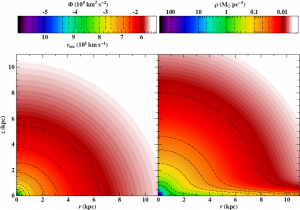Stellar Kinematics
Our Milky Way is a complex dynamical system which hosts a variety of different stellar populations. Characteristics of the latter are, e.g., the kinematics, ages, and chemical compositions of their members. Population I stars like the Sun have ages of up to a few billion years, a rather high metallicity, an almost circular orbit around the Galactic center, a very low velocity component perpendicular to the disk, and are typically members of the thin disk. Population II stars, on the other hand, are old (more than ten billion years), metal poor, on elliptical trajectories which are not aligned to the Galactic plane and which have large vertical velocity components, and usually found in the globular clusters of the halo. By studying the kinematic properties of stars, we can draw conclusions about their population membership and, thus, about their nature and origin. Research topics in which we are particularly interested in are the modeling of the gravitational potential of the Milky Way and the study of the enigmatic runaway and hypervelocity stars.
Milky Way mass models
Tracking large-scale orbits within the Milky Way is an important ingredient in the study of the dynamical properties of stars, globular clusters, or satellite galaxies. Given the object’s coordinates and velocity components, this is a straightforward task once the Galactic gravitational potential is available. Owing to a lack of observational constraints, a great deal of the Milky Way’s mass distribution – in particular of its dark matter halo – remains still unknown. Therefore, different mass models are able to reproduce the observations equally well. For the purpose of numerical orbit calculations, a mathematically simple and analytically closed potential is preferred because it supports fast computations. However, with the steadily growing knowledge about the structure of our Milky Way, e.g., boosted by the Gaia mission, it will be a crucial task in the next years to come up with more complex and realistic forms for the Galactic gravitational potential that are still suitable for fast numerical computations.

A model for the gravitational potential (left) and mass distribution (right) of the Milky Way as a function of cylindrical coordinates (Courtesy of A. Irrgang).
Runaway and Hypervelocity Stars
Runaway stars are objects that are currently leaving or already have left their place of birth. For instance, young, massive stars in the Galactic halo are far away from Milky Way’s star forming regions, i.e., its spiral arms within the Galactic plane. Those objects are widely supposed to be the result of an ejection event that forced them to leave their host cluster in the Galactic disk. Possible ejection scenarios are the tidal disruption of a binary system by a supermassive black hole (called slingshot mechanism or “Hills mechanism”, animation), dynamical interactions in dense star clusters, e.g., close binary-binary encounters ejecting one (animation) or even two (animation) stars, or a supernova explosion in a binary system (animation). Among the different ejection scenarios, the Hills mechanism is most powerful in terms of ejection velocities (up to thousand kilometers per second). It is supposed to be responsible for a very rare class of extreme velocity stars, the so-called hypervelocity stars, traveling at such a high velocity that one day they will escape from the Milky Way. Because the Galactic center is the only region known to host a supermassive black hole, it is the suggested place of origin for the hypervelocity stars. We perform combined kinematic and spectroscopic investigations of runaway and hypervelocity stars in order to distinguish between the different ejection channels and, in this way, to unravel their origin and nature.
(The animations linked in this paragraph were provided courtesy of A. Irrgang.)
Galactic population of stars
The Milky Way consists of a central bulge and a rotating disk of stars of all ages embedded in an extended halo of old stars. The Galactic disk can be roughly divided in a thin and a thick disk, which show different kinematics. Analyses of the individual Galactic orbits can be used to characterize the population membership of samples of stars. Of particular interest is the identification of halo stars. We focus on white dwarfs and hot subluminous stars.



